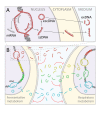Extracellular DNA secreted in yeast cultures is metabolism-specific and inhibits cell proliferation
- PMID: 38053574
- PMCID: PMC10695634
- DOI: 10.15698/mic2023.12.810
Extracellular DNA secreted in yeast cultures is metabolism-specific and inhibits cell proliferation
Abstract
Extracellular DNA (exDNA) can be actively released by living cells and different putative functions have been attributed to it. Further, homologous exDNA has been reported to exert species-specific inhibitory effects on several organisms. Here, we demonstrate by different experimental evidence, including 1H-NMR metabolomic fingerprint, that the growth rate decline in Saccharomyces cerevisiae fed-batch cultures is determined by the accumulation of exDNA in the medium. Sequencing of such secreted exDNA represents a portion of the entire genome, showing a great similarity with extrachromosomal circular DNA (eccDNA) already reported inside yeast cells. The recovered DNA molecules were mostly single strands and specifically associated to the yeast metabolism displayed during cell growth. Flow cytometric analysis showed that the observed growth inhibition by exDNA corresponded to an arrest in the S phase of the cell cycle. These unprecedented findings open a new scenario on the functional role of exDNA produced by living cells.
Keywords: 1H NMR; cell cycle; eccDNA; exDNA; metabolomics; self-DNA.
Copyright: © 2023 de Alteriis et al.
Conflict of interest statement
Conflict of Interest: SM, EdA, GI, FC, MLC, PT, GB, VL, following the discovery of self-DNA inhibition in plants and other organisms, founded the Noself srl company, owner of the patent WO2014020624A9. The patent includes a method for improving the production of microorganisms in bioreactors by removal of DNA inhibition from the culture medium. During the period of development of this research, the PhD grant of EP at the Zoological Station of Naples A. Dohrn has been co-financed by Noself srl. All the other authors have no competing interests.
Figures






References
-
- Ascher J, Ceccherini MT, Pantani OL, Agnelli A, Borgogni F, Guerri G, Nannipieri P, Pietramellara G. Sequential extraction and genetic fingerprinting of a forest soil metagenome. Appl Soil Ecol. 2009;42(2):176–181. doi: 10.1016/j.apsoil.2009.03.005. - DOI
LinkOut - more resources
Full Text Sources
